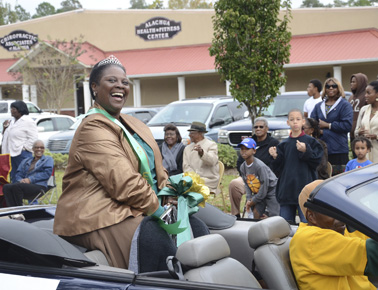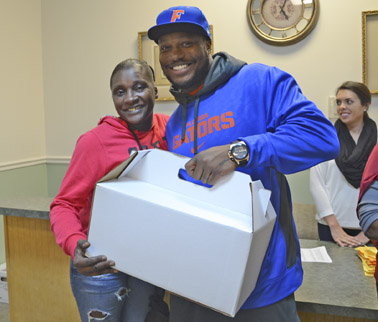
CARL MCKINNEY/Alachua County Today
Wanda Boyd, "Ms. Green and Gold," smiles as she rides down Main Street. She was crowned the night before the parade at Paradise Methodist Church.
ALACHUA – There was a buzz on the streets of downtown Alachua on Saturday afternoon, Nov. 30.
The Hornet alumni of A.L. Mebane High School came together to celebrate their school in unity at the A.L. Mebane High School Reunion parade, which started at noon and lasted about an hour.
“This is something that we look forward to each and every year,” said Hilda Mulberry, an onlooker at the parade.
The alumni of Mebane High School, their families and members of the black community lined the sidewalks of Bob Hitchcock’s Main Street in Alachua to celebrate the rich history of the former all-black institution, which was desegregated in 1971.
“They’re trying to make it better every year,” said Orian Lumpkin, a 1961 Mebane High School graduate.
The event began at noon, but the crowd had arrived well before the start of the parade. Former classmates, current students and their teachers gathered together to share stories and reminisce.
Some of those in attendance leaned against the walls of local businesses or simply sat on the street’s curb, while others leisurely relaxed in the lawn chairs they had brought from their homes to enjoy the show.
Byran Williams, the newly chosen mayor of High Springs, believes that this year’s reunion turnout, although still abundant with attendees, was slightly down from previous years. The reason might have been the annual football game held between the University of Florida Gators and their rivals, the Florida State Seminoles, which was played in Gainesville during the parade.
“A lot of people stayed at home to watch the game,” said Mayor Williams, who said he was still happy with the turnout.
The Mebane Hornets football team, a former football powerhouse itself, according to Lumpkin and Williams, went undefeated in 1964 while the school was still segregated. Many of those that attended schools in the area during that time proudly recalled their memories of that perfect season.
“Mebane High School has a rich history,” Mayor Williams said. “Mebane had one of the best football teams in the state of Florida.”
The parade, which lasted about an hour, seemed to be enjoyed by those young and old alike. Several Mebane graduates, riding on their class floats, threw candy to eager children who rushed to the streets to claim their sugary rewards.
The crowd came to life as the Ms. Alumni and Little Miss Alumni Pageant winners, Barbara White and Trinity Johnson, waived to the crowd. Both were crowned the previous evening at the Paradise United Methodist Church in Alachua.
Katie Jones became nostalgic as the floats carrying her former peers passed by.
It had been years since she attended the school, but being in the presence of so many familiar faces brought the past back to life.
“It’s been so long,” Jones said. “It brings back so many memories.”
Mayor Williams came close to having some memories to share with the crowd, but his life went in another direction. He expected to become a Mebane Hornet but was sent to Santa Fe High School instead, due to the desegregation of Florida schools, prior to his freshman year in 1972.
It took time for him to adjust to the new environment.
“There was a lot of tension,” Williams said. “It was quite a change.”
Williams was in eighth grade when Florida desegregated their public schools in 1971. Following the parade, he recalled how sudden that change was.
“To make that transition, it was a bit of a challenge,” Williams said. “They didn’t prepare us. We were never introduced to our new teachers or principals. We did not have counseling. No one let us know why this happened, why we had to integrate.”
Eventually the tensions eased and friendships formed when the students got to know one another.
“There was still racism, but the majority of us got along real well,” he said.
The A.L. Mebane High School Reunion provided a forum for members of the African-American community of Alachua to come together to remember their struggle for equality in the past and to celebrate their present and future.
“The parade shows the unity of our culture,” said Ulysses Woods, an onlooker who supported that message.
“It’s about remembering that we went to an all-black school,” Orian Lumpkin said. “It was an excellent school. We were well taken care of. The teachers put more time into the kids back in the day.”
The parade concluded with former Mebane High School students, donning Western clothing and cowboy hats, riding through the crowd on horseback. As they rode off around high noon, families, friends and classmates continued to share memories, made plans to meet after the event and said their goodbyes.
Mayor Williams reflected on the solidarity of his community in the area.
“We were all part of one group.”
# # #
Email editor@
alachuatoday.com




